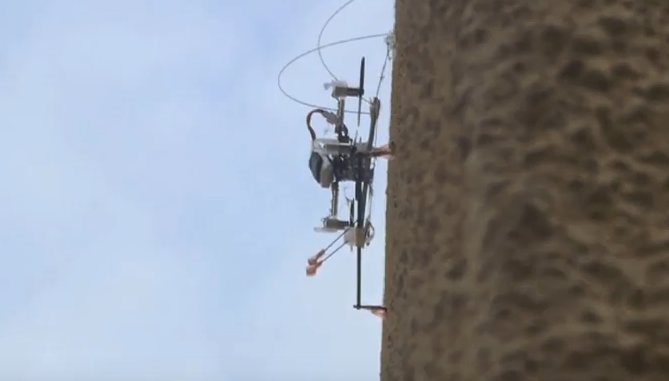
Alpha Go, a Google company has released video of an extremely versatile insect robot that can do most things any real flying insect can do. C|NET reports about the new creepy-crawly robot:
Not can the robot only fly, being propelled in the air by quadrotor helicopters, it can also land on a vertical wall then climb up it using spiny feet. When it slips a little, it can adjust on the fly.

BYPASS THE CENSORS
Sign up to get unfiltered news delivered straight to your inbox.
You can unsubscribe any time. By subscribing you agree to our Terms of Use
Latest Video
It’s called the Stanford Climbing and Aerial Maneuvering Platform, or SCAMP, and it combines lessons learned from previous machines built at the university’s Biomimetics and Dextrous Manipulation Lab.
“Quadrotors have limited endurance because of restrictions on battery capacity and the physics of small-scale flight, but perching can allow them to operate for hours or even days, gathering data or performing communication tasks while stationary,” explained Morgan Pope, lead author of a paper on the project currently in review, in an article on IEEE.
He further explains that perching perfectly is difficult for robots, but this drone is able to reposition itself if it lands improperly thanks to its climbing abilities.
The lab has been working on building climbing robots for some years, starting with spined feet that grip rough surfaces, much the same way that spiny insect feet grip surfaces. Although the lab went on to look at adhesive feet, the spined feet proved to be the most efficient method for SCAMP. They are lightweight and low-power, both of which are important for a flying machine.
The feet are also on weirdly long legs that make the robot look distinctly insect-like. They look at lot like antennae, but they’re actually based on the long legs of creatures such as daddy-long-legs spiders and stick insects. This is because long, thin, low-weight legs allow the robot to take fewer steps, which ends up more efficient.
It’s the transition between flying and wall-climbing that’s the really tricky bit. The lab has also been working on this for some time with both fixed-wing robots and quadrotor robots. What they found was that the robots lost control as they moved close to the wall.
For SCAMP, they implemented a long tail. The robot approaches the wall rear-first, with the tail making first contact. This impact is then detected by accelerometers, which stabilises the robot and acts as a pivot point from which it can straighten up, pushing itself against the wall with the rotors at maximum until the feet are pressed up against the wall and engaged.
The robot can then commence its climb. If, at any point, it slips, the sensitive accelerometers detect the free-fall and the rotors turn back on to push SCAMP back up against the wall. The rotors can also be employed to correct the angle of the robot when its weight cantilevers too far from the wall as it climbs.
It’s pretty impressive so far, but the team has even more plans in store for SCAMP.
“In future work, we’d like to implement adaptive gait control for SCAMP — algorithms that allow the robot to react to failure by dynamically changing its climbing strategy,” Pope said.
“We also see SCAMP as the starting place for an entire family of perching and climbing robots of varying scales and attachment strategies. The lessons we learned from SCAMP should allow us to tackle new surfaces, new environments, and different quadrotor platforms with new sensing and communication abilities.”


